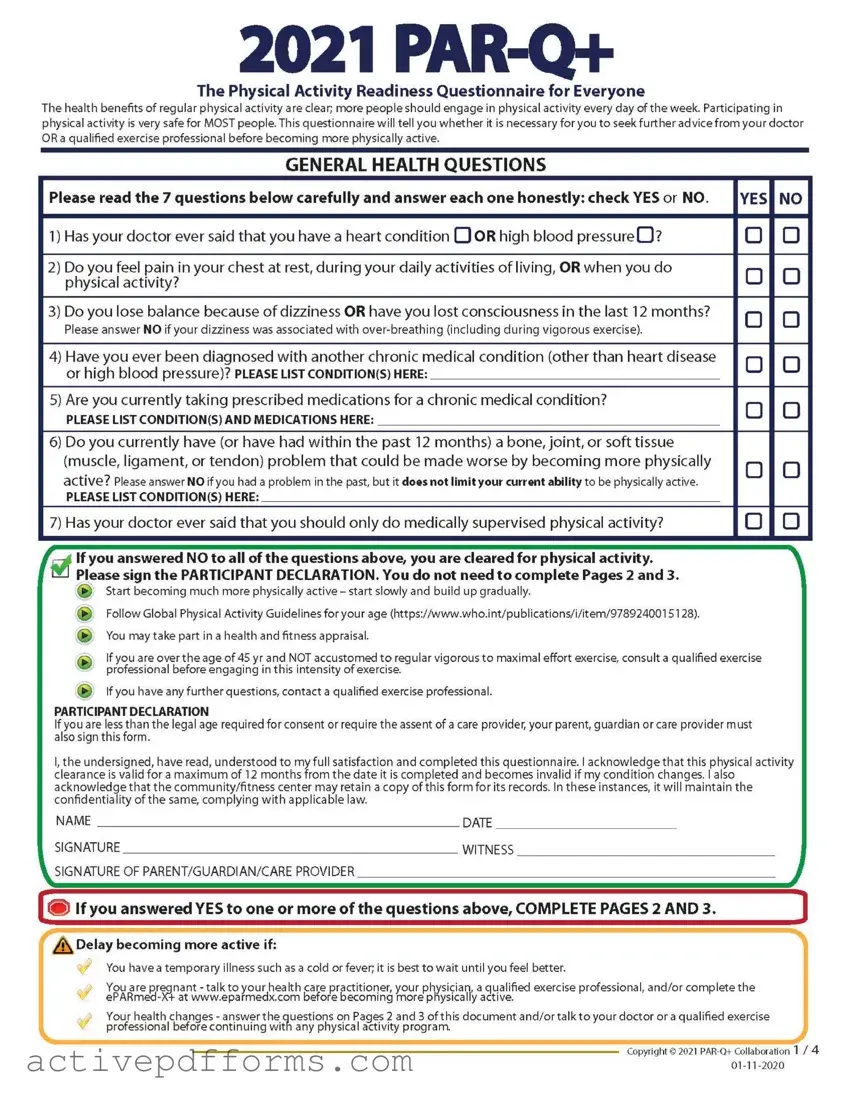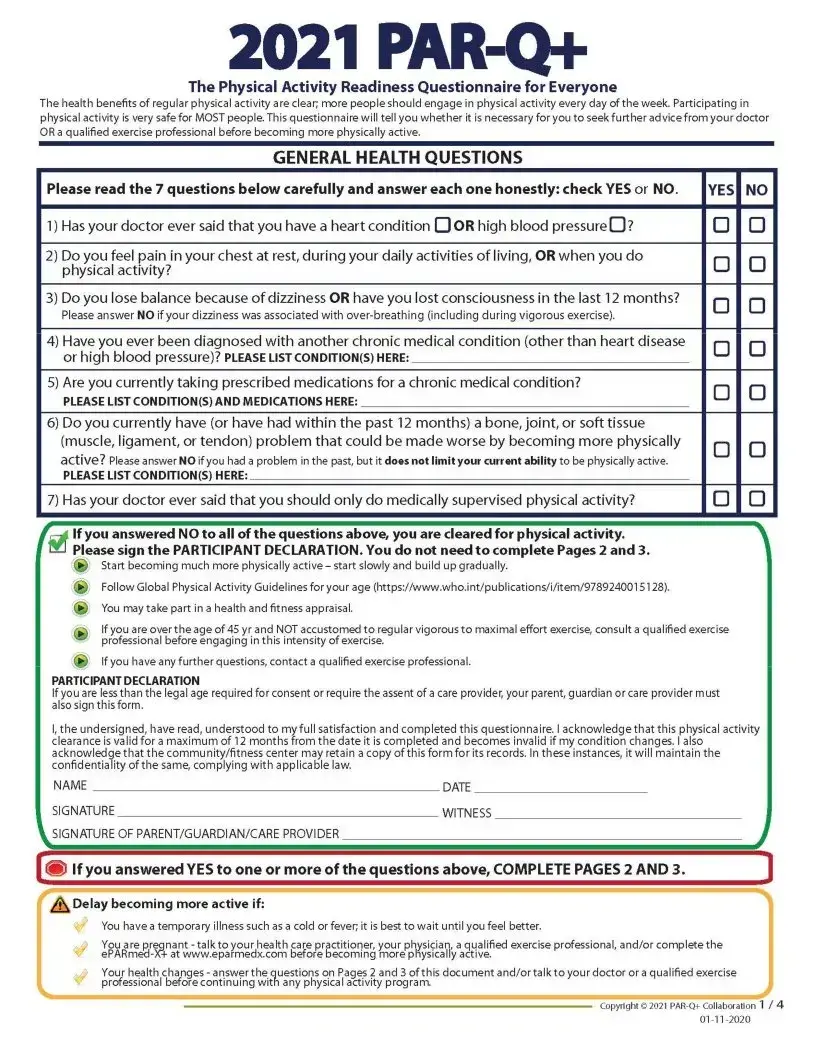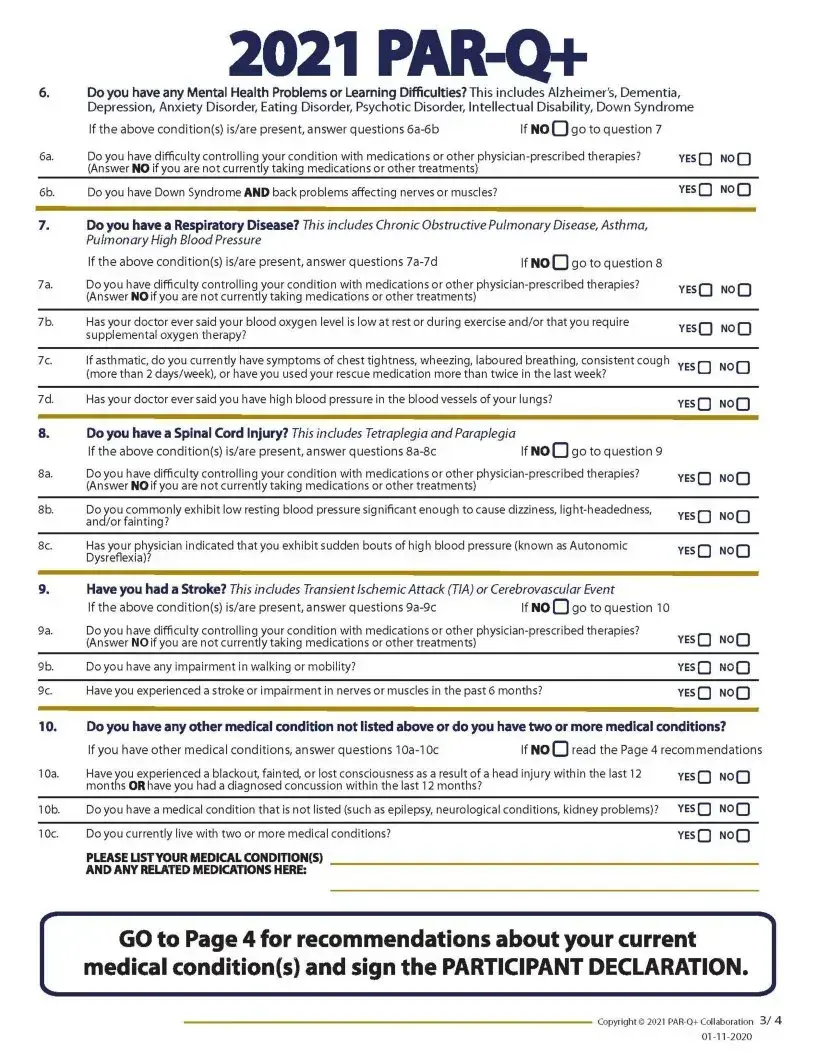2021 PAR-Q+
The Physical Activity Readiness Questionnaire for Everyone
The health benefits of regular physical activity are clear; more people should engage in physical activity every day of the week. Participating in physical activity is very safe for MOST people. This questionnaire will tell you whether it is necessary for you to seek further advice from your doctor OR a qualified exercise professional before becoming more physically active.
GENERAL HEALTH QUESTIONS
Please read the 7 questions below carefully and answer each one honestly: check YES or NO. |
YES NO |
1)Has your doctor ever said that you have a heart condition OOR high blood pressure O?
2)Do you feel pain in your chest at rest, during your daily activities of living, OR when you do physical activity?
3)Do you lose balance because of dizziness OR have you lost consciousness in the last 12 months?
Please answer NO if your dizziness was associated with over-breathing (including during vigorous exercise).
4)Have you ever been diagnosed with another chronic medical condition (other than heart disease or high blood pressure)? please listcondition(S) here:
5)Are you currently taking prescribed medications for a chronic medical condition?
PLEASE LIST CONDITION(S) AND MEDICATIONS HERE:
6)Do you currently have (or have had within the past 12 months) a bone, joint, or soft tissue (muscle, ligament, or tendon) problem that could be made worse by becoming more physically
active? Please answer NO if you had a problem in the past, but it doesnot limit your current ability to be physically active.
PLEASE LIST CONDITION(S) HERE:
7) Has your doctor ever said that you should only do medically supervised physical activity?
If you answered NO to all of the questions above, you are cleared for physical activity.
—I Please sign the PARTICIPANT DECLARATION. You do not need to complete Pages 2 and 3.
Start becoming much more physically active - start slowly and build up gradually.
Follow Global Physical Activity Guidelines for your age (https://www.who.int/publications/i/item/9789240015128).
You may take part in a health and fitness appraisal.
If you are over the age of 45 yr and NOT accustomed to regular vigorous to maximal effort exercise, consult a qualified exercise professional before engaging in this intensity of exercise.
►If you have any further questions, contact a qualified exercise professional.
PARTICIPANT DECLARATION
If you are less than the legal age required for consent or require the assent of a care provider, your parent, guardian or care provider must also sign this form.
I, the undersigned, have read, understood to my full satisfaction and completed this questionnaire. I acknowledge that this physical activity clearance is valid for a maximum of 12 months from the date it is completed and becomes invalid if my condition changes. I also acknowledge that the community/fitness center may retain a copy of this form for its records. In these instances, it will maintain the confidentiality of the same, complying with applicable law.
NAME |
DATE |
SIGNATURE _____________________________________ |
WITNESS |
SIGNATURE OF PARENT/GUARDIAN/CARE PROVIDER |
|
[i® If you answered YES to one or more of the questions above, COMPLETE PAGES 2 AND 3.
/*\ Delay becoming more active if:
You have a temporary illness such as a cold orfever; it is best to wait until you feel better.
You are pregnant - talk to your health care practitioner, your physician, a qualified exercise professional, and/or complete the ePARmed-XT at www.eparmedx.com before becoming more physically active.
Your health changes - answer the questions on Pages 2 and 3 of this document and/ortalkto your doctor ora qualified exercise professional before continuing with any physical activity program.
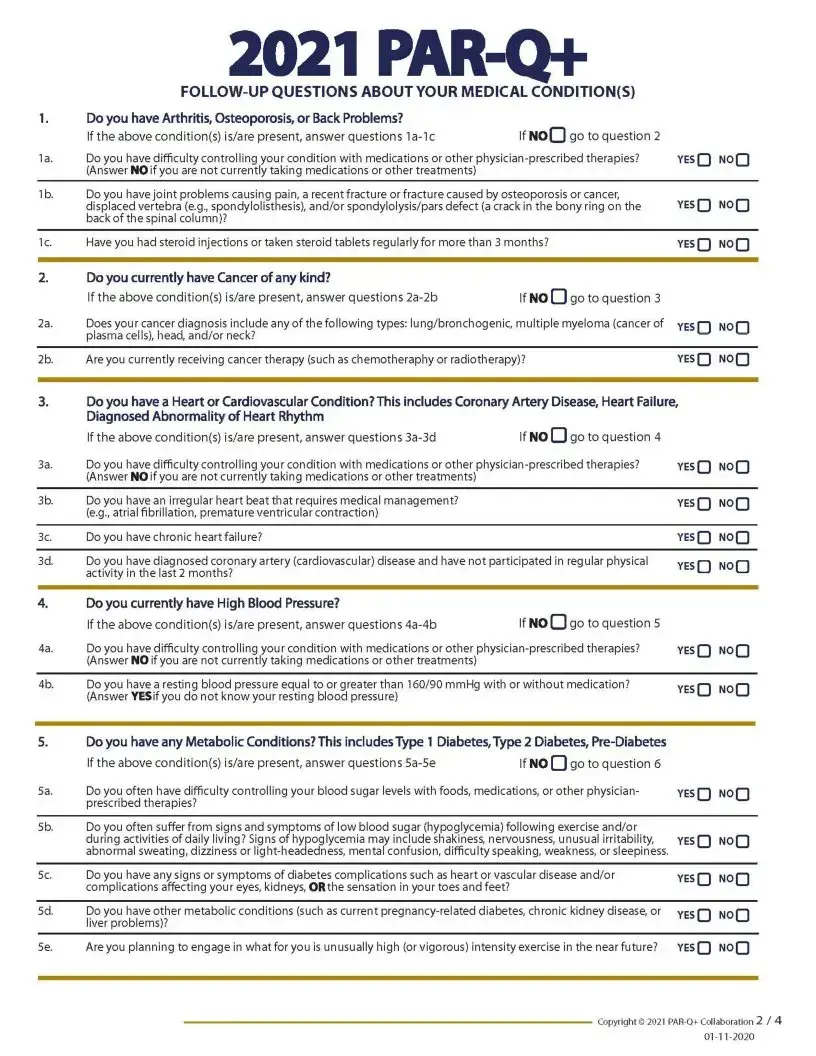
2021 PAR-Qt
FOLLOW-UP QUESTIONS ABOUT YOUR MEDICAL CONDITION(S)
1.Do you have Arthritis, Osteoporosis, or Back Problems?
|
If the above condition(s) is/are present, answer questions la-lc |
If noQ go to question 2 |
|
la. |
Do you have difficulty control ling your condition with medications or other physician-prescribed therapies? |
yesQ NOQ |
|
(Answer NO if you are not currently taking medications or other treatments) |
|
|
lb. |
Do you have joint problems causing pain, a recent fracture or fracture caused by osteoporosis or cancer, |
YESQ NOQ |
|
displaced vertebra (e.g., spondylolisthesis), and/or spondylolysis/pars defect (a crack in the bony ring on the |
|
back of the spinal column)? |
|
|
1c. |
Have you had steroid injections or taken steroid tablets regularly for more than 3 months? |
YESQ NOQ |
2.Do you currently have Cancer of any kind?
|
If the above condition(s) is/are present, answer questions 2a-2b |
If NO O go to question 3 |
|
2a. |
Does your cancer diagnosis include any of the following types: lung/bronchogenic, multiple myeloma (cancer of |
yes[“) NO t-) |
|
plasma cells), head, and/or neck? |
|
u |
2b. |
Are you currently receiving cancer therapy (such as chemotheraphy or radiotherapy)? |
YESQ NOQ |
3.Do you have a Heart or Cardiovascular Condition? This includes Coronary Artery Disease, Heart Failure, Diagnosed Abnormality of Heart Rhythm
If the above condition(s) is/are present, answer questions 3a-3d |
If NO |
go to question 4 |
3a. Do you have difficulty controlling your condition with medications or other physician-prescribed therapies? (Answer NO if you are not currently taking medications or other treatments)
3 b. Do you have an irregular heart beat that requires medical management? (e.g., atrial fibrillation, premature ventricular contraction)
3c. Do you have chronic heart failure?
3d. Do you have diagnosed coronary artery (cardiovascular) disease and have not participated in regular physical activity in the last 2 months?
4. |
Do you currently have High Blood Pressure? |
|
|
If the above condition(s) is/are present, answer questions 4a-4b |
If NO O 9° to question 5 |
4a. |
Do you have difficulty controlling your condition with medications or other physician-prescribed therapies? |
|
(Answer NO if you are not currently taking medications or other treatments) |
|
4b. |
Do you have a resting blood pressure equal to or greater than 160/90 mmHg with or without medication? |
|
(Answer YES if you do not know your resting blood pressure) |
|
YESQ NOQ
yesQ NOQ
yesQ NOQ
YESQ NOQ
yesQ NOQ
YESQ NOQ
5.Do you have any Metabolic Conditions? This includes Type 1 Diabetes,Type 2 Diabetes, Pre-Diabetes
|
If the above condition(s) is/are present, answer questions 5a-5e |
If NO [~] go to question 6 |
|
|
5a. |
Do you often have difficulty controlling your blood sugar levels with foods, medications, or other physician- |
YESQ |
NOQ |
|
prescribed therapies? |
|
|
|
5 b. |
Do you often suffer from signs and symptoms of low blood sugar (hypoglycemia) following exercise and/or |
|
|
|
during activities of daily living? Signs of hypoglycemia may include shakiness, nervousness, unusual irritability, |
YESQ |
NOQ |
abnormal sweating, dizziness or light-headedness, mental confusion, difficulty speaking, weakness, or sleepiness.
5c. |
Do you have any signs or symptoms of diabetes complications such as heart or vascular disease and/or |
YESQ NOQ |
|
complications affecting your eyes, kidneys, ORthe sensation in your toes and feet? |
|
5d. Do you have other metabolic conditions (such as current pregnancy-related diabetes, chronic kidney disease, or liver problems)?
5e. Are you planning to engage in what for you is unusually high (or vigorous) intensity exercise in the near future?
---------------------------------------------------------------------------------------------------------------------------------------------- Copyright© 2021 PAR-Q+Collaboration 2 / 4
01-11-2020
2021 PAR-Q+
6.Do you have any Mental Health Problems or Learning Difficulties? This includes Alzheimer's, Dementia, Depression, Anxiety Disorder, Eating Disorder, Psychotic Disorder, Intellectual Disability, Down Syndrome
|
If the above condition(s) is/are present, answer questions 6a-6b |
If NO O go to question 7 |
|
6a. |
Do you have difficulty controlling your condition with medications or other physician-prescribed therapies? |
yesQ NOQ |
|
(Answer NO if you are not currently taking medications or other treatments) |
|
|
6b. |
Do you have Down Syndrome AND back problems affecting nerves or muscles? |
|
yesQ NOQ |
7.Do you have a Respiratory Disease? This includes Chronic Obstructive Pulmonary Disease, Asthma, Pulmonary High Blood Pressure
If the above condition(s) is/are present, answer questions 7a-7d |
|f NO Q go to question 8 |
7a. Do you have difficulty controlling your condition with medications or other physician-prescribed therapies? (Answer NO if you are not currently taking medications or other treatments)
7 b. Has your doctor ever said your blood oxygen level is low at rest or during exercise and/or that you require supplemental oxygen therapy?
7c. If asthmatic, do you currently have symptoms of chest tightness, wheezing, laboured breathing, consistent cough (more than 2 days/week), or have you used your rescue medication more than twice in the last week?
7d. Has your doctor ever said you have high blood pressure in the blood vessels of your lungs?
8.Do you have a Spinal Cord Injury? This includes Tetraplegia and Paraplegia
If the above condition(s) is/are present, answer questions 8a-8c |
If NO O go to question 9 |
8a. Do you have difficulty controlling your condition with medications or other physician-prescribed therapies? (Answer NO if you are not currently taking medications or other treatments)
8 b. Do you commonly exhibit low resting blood pressure significant enough to cause dizziness, light-headedness, and/or fainting?
8c. Has your physician indicated that you exhibit sudden bouts of high blood pressure (known as Autonomic Dysreflexia)?
9.Have you had a Stroke? This includes Transient Ischemic Attack (TIA) or Cerebrovascular Event
If the above condition(s) is/are present, answer questions 9a-9c |
If NO Q go to question 10 |
9a. Do you have difficulty controlling your condition with medications or other physician-prescribed therapies? (Answer NO if you are not currently taking medications or other treatments)
9 b. Do you have any impairment in walking or mobility?
9c. Have you experienced a stroke or impairment in nerves or muscles in the past 6 months?
YESQ noQ
yesQ noQ
yesQ NOQ
YESQ NoQ
yesQ NoQ
yesQ NOQ
yesQ noQ
yesQ NOQ
yesQ NOQ
YESQ NOQ
10.Do you have any other medical condition not listed above or do you have two or more medical conditions?
|
If you have other medical conditions, answer questions lOa-IOc |
If NqQ read the Page 4 recommendations |
10a. |
Have you experienced a blackout, fainted, or lost consciousness as a result of a head injury within the last 12 |
YESQ |
NOQ |
|
months OR have you had a diagnosed concussion within the last 12 months? |
|
|
|
10b. |
Do you have a medical condition that is not listed (such as epilepsy, neurological conditions, kidney problems)? |
YESQ |
NoQ |
10c. |
Do you currently live with two or more medical conditions? |
|
YESQ |
NOQ |
|
PLEASE LISTYOUR MEDICAL CONDITION(S) |
|
|
|
|
AND ANY RELATED MEDICATIONS HERE: |
|
|
|
GO to Page 4 for recommendations about your current medical condition(s) and sign the PARTICIPANT DECLARATION.
---------------------------------------------------------------------------------------------------------------------------------------------- Copyright© 2021 PAR-Q+Collaboration 3/ 4
01-11-2020
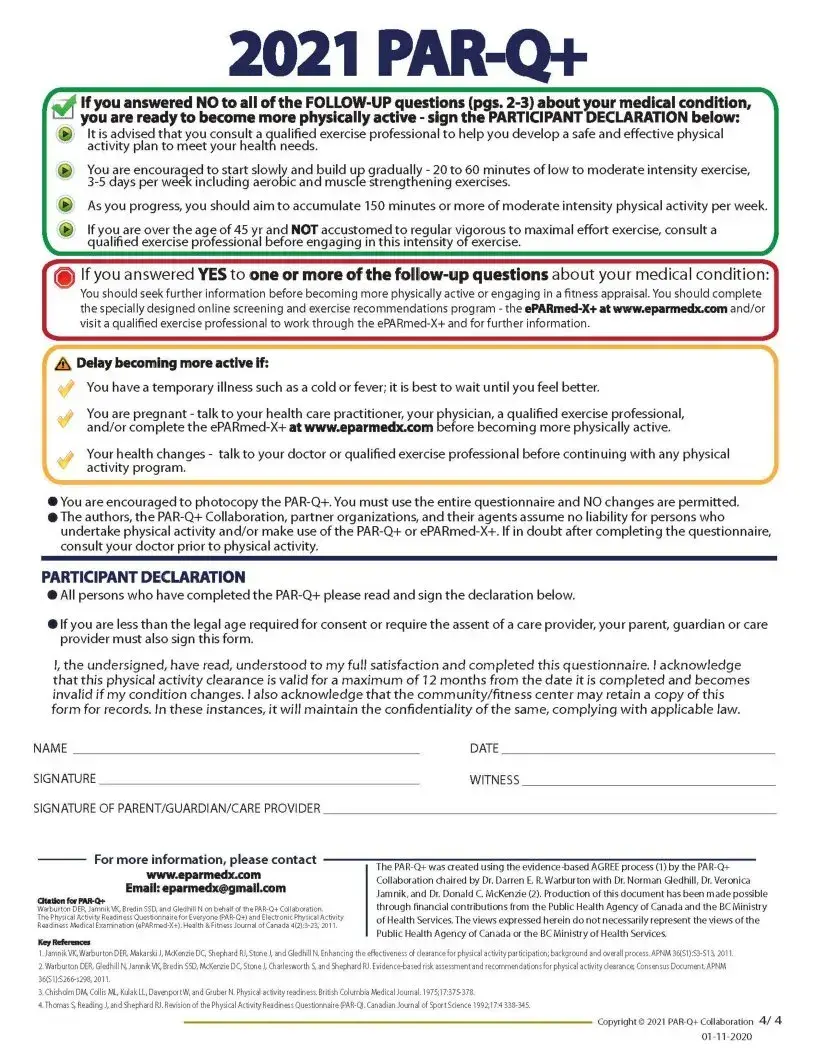
2021 PAR-Ql-
You have a temporary illness such as a cold or fever; it is best to wait until you feel better.
You are pregnant - talk to your health care practitioner, your physician, a qualified exercise professional,
and/or complete the ePARmed-X+ at www.eparmedx.com before becoming more physically active.
Your health changes - talk to your doctor or qualified exercise professional before continuing with any physical activity program.
•You are encouraged to photocopy the PAR-Q+. You must use the entire questionnaire and NO changes are permitted.
•The authors, the PAR-Q+ Collaboration, partner organizations, and their agents assume no liability for persons who undertake physical activity and/or make use of the PAR-Q+ or ePARmed-X+. If in doubt after completing the questionnaire, consult your doctor prior to physical activity.
PARTICIPANT DECLARATION
•All persons who have completed the PAR-Q+ please read and sign the declaration below.
•If you are less than the legal age required for consent or require the assent of a care provider, your parent, guardian or care provider must also sign this form.
I, the undersigned, have read, understood to my full satisfaction and completed this questionnaire. I acknowledge that this physical activity clearance is valid for a maximum of 12 months from the date it is completed and becomes invalid if my condition changes. I also acknowledge that the community/fitness center may retain a copy of this form for records. In these instances, it will maintain the confidentiality of the same, complying with applicable law.
NAME
SIGNATURE
SIGNATURE OF PARENT/GUARDIAN/CARE PROVIDER
----------- For more information, please contact
www.eparmedx.com
Email: eparmedx^gmailxom
Otttfcn for PAR-O+
Warburton DER, Jamnik VK, Bred in SSD, and Gledhill N on behalf of the PAR-Q+ Collaboration.
The Physical Activity Readiness Questionnaire for Everyone (PAR-Q+) and Electronic Physical Activity Readiness Medical Examination (ePARmed-X+). Health & Fitness Journal of Canada 4(2)3-23, 2011.
Key Referanees
DATE
WITNESS
The PAR-Q+ was created using the evidence-based AGREE process (1) by the PAR-Q+
Collaboration chaired by Dr. Darren E. R. Warburton with Dr. Norman Gledhill, Dr. Veronica Jamnik,and Dr. Donald C. McKenzie (2). Production of this document has been made possible through financial contributions from the Public Health Agency of Canada and the BC Ministry of Health Services. The views expressed herein do not necessarily represent the views of the
Public Health Agency of Canada or the BC Ministry of Health Services.
1.Jamnik VK, Warburton DER, Makarski J, McKenzie DC, Shephard RJ, Stone J, and Gledhill N. Enhancing the effectiveness of clearance for physical activity participation; background and overall process. APNM 36(S1):S3-S13, 2011.
2.Warburton DER, Gledhill N,JamnikVK, Bredin SSD, McKenzie DC, Stone J, Charlesworth S, and Shephard RJ. Evidence-based risk assessment and recommendations for physical activity clearance; Consensus Document. APNM 36(S1>:S266-s298,20l1.
3.Chisholm DM, Collis ML, Kulak LL, DavenportW, and Gruber N. Physical activity readiness. British Columbia Medical Journal. 1975;17:375-378.
4.Thomas S, Reading J, and Shephard RJ. Revision of the Physical Activity Rea din ess Questionnaire (PAR-C&. Canadian Journal of Sport Science 1992;17:4 338-345.
---------------------------------------------------------------------------------------------------------------------------------------------- Copyright© 2021 PAR-Q+Collaboration 4/ 4
01 -11-2020
